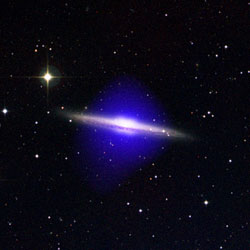NGC 5746: Detection of Hot Halo Gets Theory Out of Hot Water

Credit: X-ray: NASA/CXC/U. Copenhagen/K.Pedersen et al; Optical: Palomar DSS
Chandra observations of the massive spiral galaxy NGC 5746 revealed a large halo of hot gas (blue) surrounding the optical disk of the galaxy (white). The halo extends more than 60,000 light years on either side of the disk of the galaxy, which is viewed edge-on.
The galaxy shows no signs of unusual star formation, or energetic activity from its nuclear region, making it unlikely that the hot halo is produced by gas flowing out of the galaxy. Computer simulations and Chandra data show that the likely origin of the hot halo is the gradual inflow of intergalactic matter left over from the formation of the galaxy.
Spiral galaxies are thought to form from enormous clouds of intergalactic gas that collapse to form spinning disks of stars and gas. One prediction of this theory is that massive spiral galaxies should be immersed in halos of hot gas left over from the galaxy formation process.
Hot gas has been detected around spiral galaxies in which vigorous star formation is ejecting matter from the galaxy, but until now, hot halos due to infall of intergalactic matter had not been detected. Indeed, the extensive hot gas halo around NGC 5746 is faint and would be very difficult to detect without a powerful X-ray telescope such as Chandra. Also, the galaxy’s special orientation and large mass increased the chance of detection.
The discovery of a hot halo around NGC 5746 was welcome news to astronomers because it shows that the “missing” hot halos predicted by computer models in fact exist.
Fast Facts for NGC 5746:
Credit X-ray: NASA/CXC/U. Copenhagen/K.Pedersen et al; Optical: Palomar DSS
Scale Image is 13.3 arcmin across
Category Normal Galaxies & Starburst Galaxies
Coordinates (J2000) RA 14h 44m 55.90s | Dec Dec +01º 57’ 19.00″
Constellation Virgo
Observation Date 11 Apr 2003
Observation Time 10 hours
Obs. ID 3929
Orientation North is to the left, East is down
Color Code Energy: X-ray: Blue; Optical: White
Instrument ACIS
References K. Pedersen et al. 2006 New Astronomy (in press). see also astro-ph/0511682
Distance Estimate About 100 million light years
Release Date February 03, 2006
Media Contact
All latest news from the category: Physics and Astronomy
This area deals with the fundamental laws and building blocks of nature and how they interact, the properties and the behavior of matter, and research into space and time and their structures.
innovations-report provides in-depth reports and articles on subjects such as astrophysics, laser technologies, nuclear, quantum, particle and solid-state physics, nanotechnologies, planetary research and findings (Mars, Venus) and developments related to the Hubble Telescope.
Newest articles

Webb captures top of iconic horsehead nebula in unprecedented detail
NASA’s James Webb Space Telescope has captured the sharpest infrared images to date of a zoomed-in portion of one of the most distinctive objects in our skies, the Horsehead Nebula….

Cost-effective, high-capacity, and cyclable lithium-ion battery cathodes
Charge-recharge cycling of lithium-superrich iron oxide, a cost-effective and high-capacity cathode for new-generation lithium-ion batteries, can be greatly improved by doping with readily available mineral elements. The energy capacity and…

Novel genetic plant regeneration approach
…without the application of phytohormones. Researchers develop a novel plant regeneration approach by modulating the expression of genes that control plant cell differentiation. For ages now, plants have been the…





















